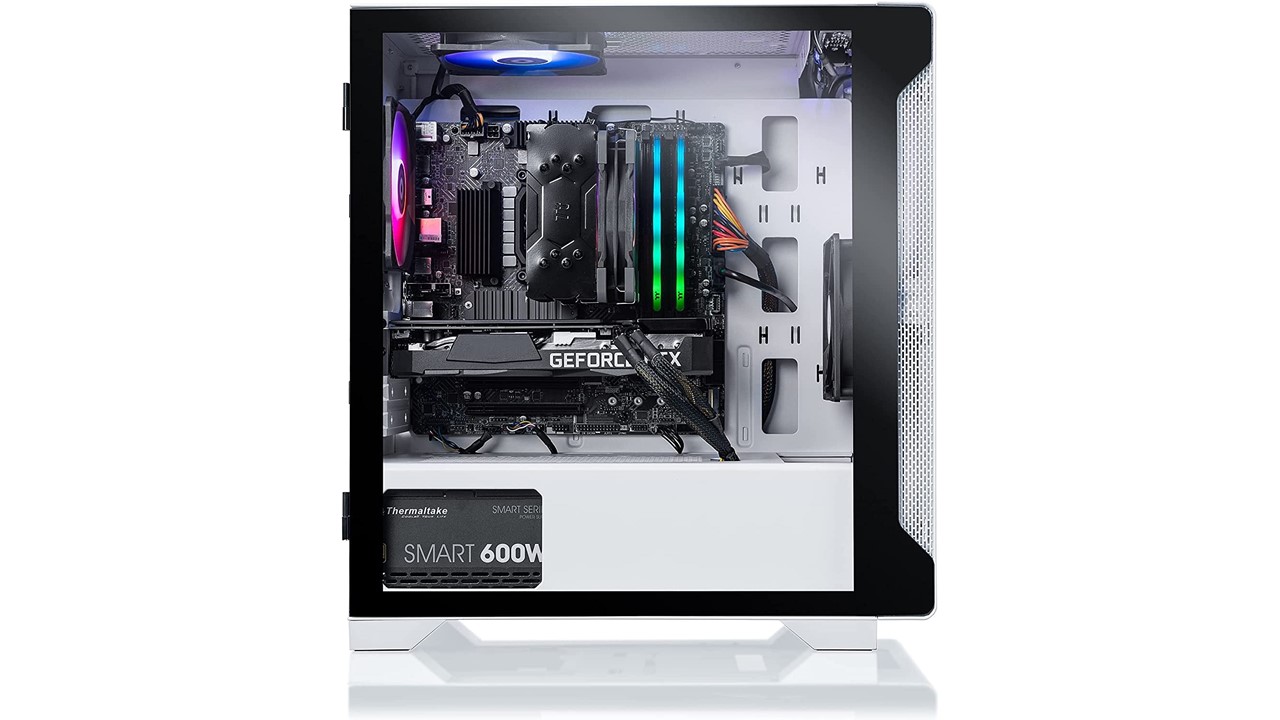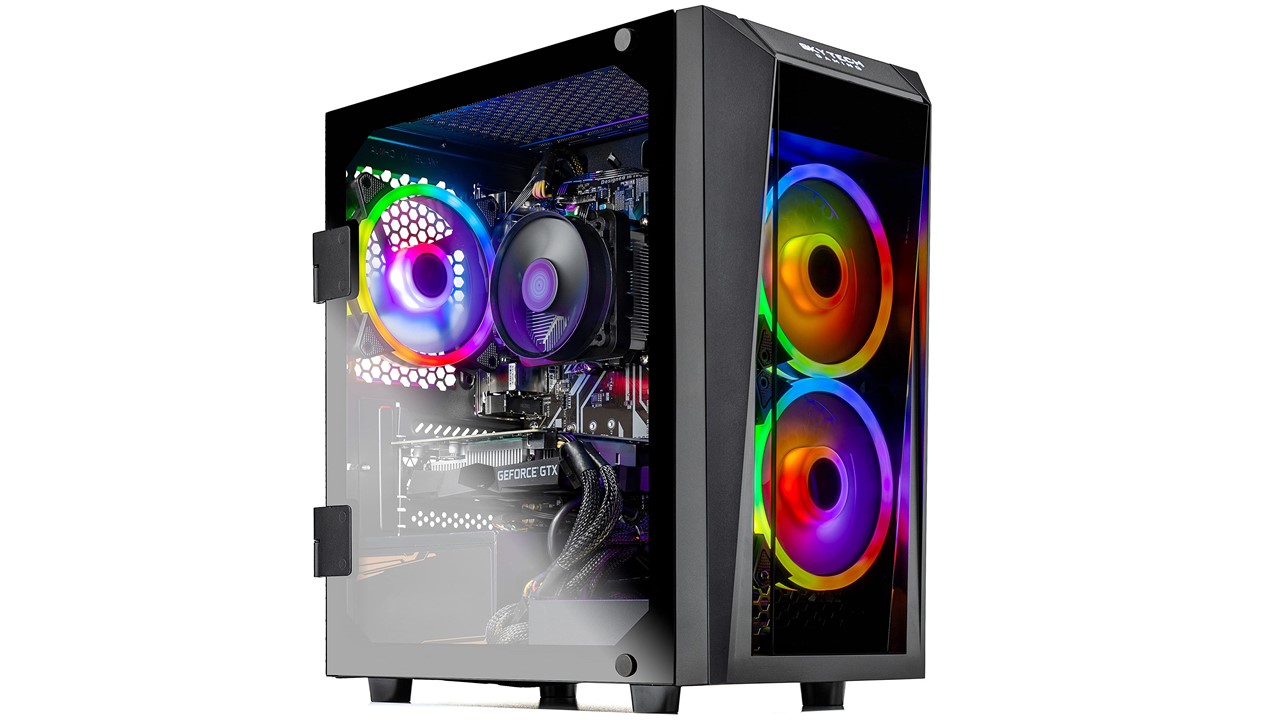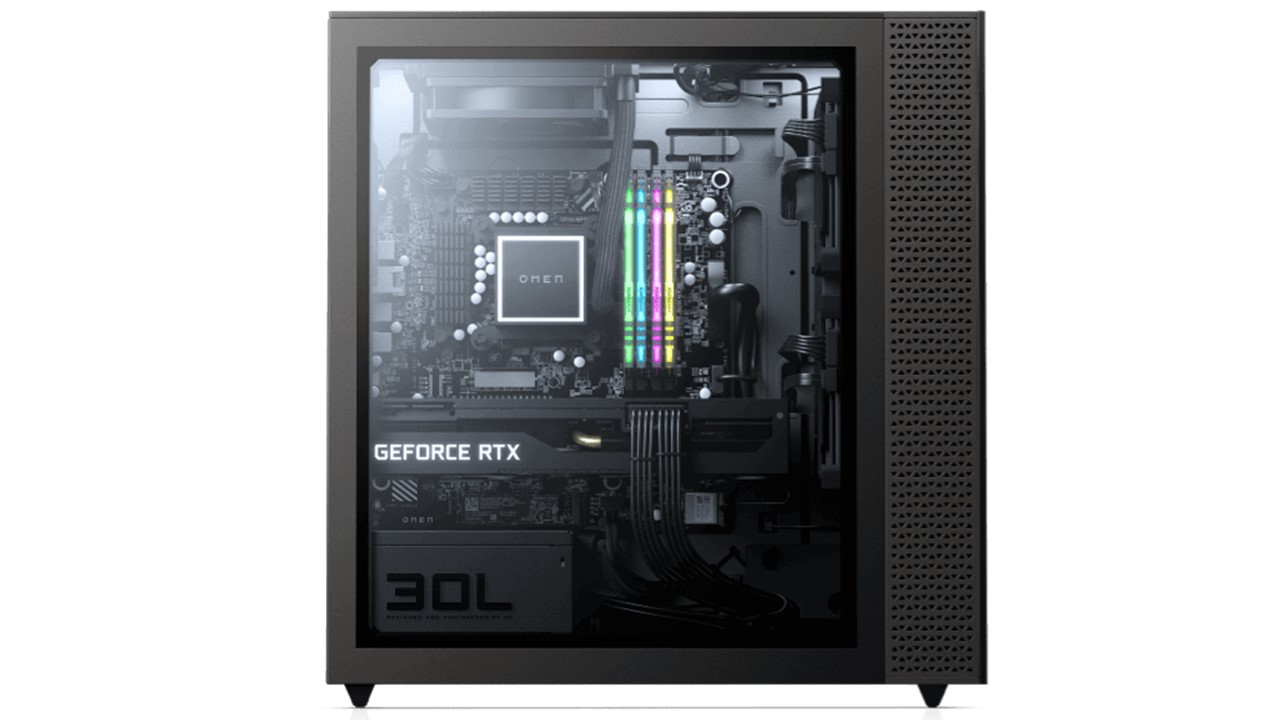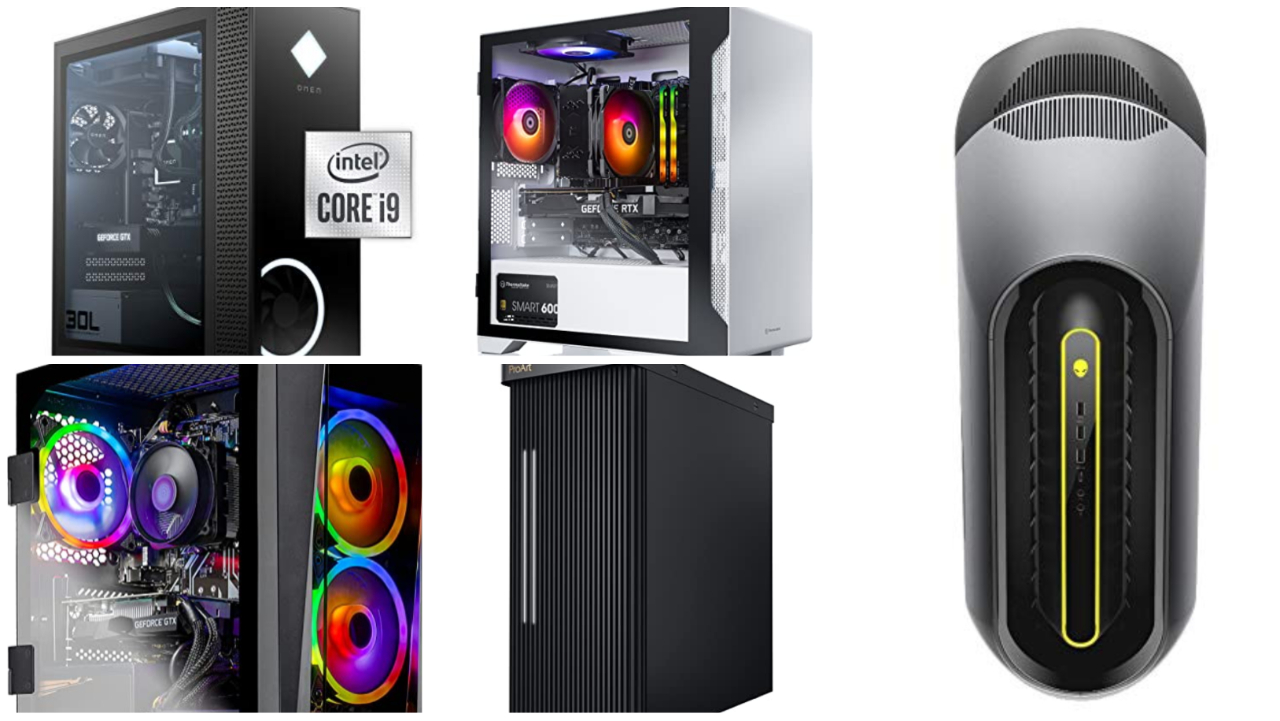Assuming that you already know if the Unreal Engine 5 platform suits you, we have something here that can help you decide on a desktop that would be used for developing purposes.
It won’t matter if you are a beginner or if you have been working with heavy projects, these desktops have been handpicked keeping in mind certain things such as performance requirements and budget.
TOP PICKS:
In This Article
Minimum & Recommended System Requirements for Unreal Engine 5
Unreal Engine 5 is a powerful game engine. To run it effectively, certain hardware requirements need to be met.
The minimum system requirements for running Unreal Engine 5 include a Ryzen 5 3600, 8GB of RAM, an NVIDIA GeForce GTX 1660 Ti graphics card, and a 500GB SSD.
If you have maintained these minimum requirements in your PC, then you can’t expect to get top-notch performance from the system when working on this game engine.
If you want to get professional-level performance, then you need to maintain high-end configurations like an Intel Core i9-10850K, 32GB of RAM, an NVIDIA GeForce RTX 3090, and 1 TB PCIe NVMe M.2 SSD or more storage.
Minimum System Requirements: Ryzen 5 3600 | 8GB RAM | NVIDIA GeForce GTX 1660 Ti | 500GB SSD.
Recommended System Requirements: Intel Core i9-10850K or better processor | 32GB RAM or more | NVIDIA GeForce RTX 3090 or better GPU | 1 TB PCIe NVMe M.2 SSD or more storage.
5 Best Desktops for Unreal Engine 5:
1. Dell Alienware Aurora R10 – Best Overall

Bottom Line: The Aurora R10 sits at the top, and has all the right reasons to be here. The latest specs, great connectivity, and the overall reliability of this desktop speak for themselves when its functionality in Unreal Engine 5 is in question.
Key Features:
- Processor: AMD Ryzen 7 5800X
- Graphics: NVIDIA GeForce RTX 3070
- OS: Windows 10 Home
- RAM: 32 GB
- Storage: 1 TB SSD
Pros
- Unique design
- Highly customizable
- Supports overclocking
Cons
- Can be expensive
- Cooling can be an issue
- GPU upgrades are limited by small space inside the chassis
Dell Alienware Aurora R10 may not be as powerfully configured as the Omen, but it can be equipped with some solid hardware as well.
This variant of the Aurora R10 is meant for those who are looking for heavy usage of Unreal Engine 5.
The Aurora R10 also has the same design that Dell has used with some of the other models of the Aurora line-up, and it does help it stand out from the crowd.
The Alienware logo lights up when the PC is running, and this indicates that the PC is ready to provide you with some outstanding performance.
The variant we have chosen comes with an 8 core AMD Ryzen 7 processor, while there are other variants too with both AMD and Intel options available.
The GPU that you get is an RTX 3070, which given its price-to-performance ratio, makes sense if you want a video card worth every penny.
The RAM present is 32 GB, which can surely be upgraded, but the good thing is that with XMP, they offer high speeds without any tweaking on your part.
There is both an SSD installed and free bays for hard drives so that you are neither short on storage space nor responses.
The Auroras have been using a swing design with the PSU inside the chassis, which is a brilliant way to manage space. The unit, in this case, does allow you to use a better GPU, only if you can fit it inside.
The specs in the desktop make it an excellent machine for handling both CPU and GPU-intensive tasks.
Since high-quality game development or video creation is all about these, what could be better?
2. ASUS ProArt Station PD5 Desktop – Runner Up

Bottom Line: This device is packed with moderate specifications. From it, you can get top-notch performance while working on Unreal Engine 5. For its great processing speed and updated USB ports, we have placed it in the runner-up position.
Key Features:
- Processor: Intel Core i7-11700
- Graphics: NVIDIA RTX 3070
- OS: Windows 11 Home
- RAM: 32GB
- Storage: 1TB PCIe NVMe SSD
Pros
- Easy to upgrade
- USB Type C port
- Separate HDMI and display ports
Cons
- Inefficient cooling sections
- Old-school design
- No optical drive support
The ASUS ProArt Station PD5 desktop is a good option for using Unreal Engine 5 because it has a powerful Intel Core i7-11700 processor which is capable of smoothly handling this game engine.
It also comes with NVIDIA GeForce RTX 3070 graphics card which is ideal for rendering high-quality graphics and provides a smooth gaming experience.
Additionally, it has 32GB DDR4 RAM that can handle large-scale projects and can do various multitasking tasks seamlessly.
This PC has 1 TB SSD storage which allows the desktop to load Unreal Engine 5 faster and smoother.
This desktop is an excellent choice for those who are looking for a powerful, reliable, and great-performing desktop for using Unreal Engine 5.
3. Thermaltake Glacier i350 Gaming Desktop – Cooling Efficient

Bottom Line: This desktop comes with great cooling technology. Those who work on Unreal Engine 5 for a long time will be very pleased with its smooth performance and great processing speed.
Key Features:
- Processor: Intel Core i5-12400F
- Graphics: NVIDIA GeForce RTX 3050
- OS: Windows 10 Home
- RAM: 16GB
- Storage: 1TB NVMe M.2 SSD
Pros
- UX200 Thermaltake air cooler keeps this device cool under any circumstances.
- Tempered glass with swing door facility
- An updated and powerful GPU
Cons
- No USB Type C port
- Bulky outfit
- Windows 11 is missing
This PC is a good option for working on Unreal Engine 5 because it is equipped with a powerful Intel Core i5-12400F processor, 16GB of DDR4 RAM, and an NVIDIA GeForce RTX 3050 graphics card.
These components work together to provide a smooth and efficient experience when working on Unreal Engine 5 game engine.
The PC also comes with a 1 TB SSD, which can help to speed up the overall performance of the system and reduce load times.
This desktop has a very efficient cooling system, which keeps the PC cool and helps it to offer very optimal performance under any circumstances.
This desktop is a good option for working on Unreal Engine 5 due to its powerful hardware and efficient cooling system.
4. Skytech Blaze II – Value for Money

Bottom Line: This is the most pocket-friendly desktop on this list, but is capable of handling entry and mid-level projects. All you need is a RAM upgrade, and tasks on Unreal Engine 5 shouldn’t take too much time to finish up.
Key Features:
- Processor: Ryzen 5 3600
- Graphics: NVIDIA GeForce GTX 1660 Ti
- OS: Windows 10 Home
- RAM: 8 GB
- Storage: 500 GB
Pros
- Decent specs
- Affordable price tag
- Easy upgrades
Cons
- RAM and storage might be cutting it too close
- Some better connectivity could have been provided
- Fans can get loud
The final option in our collection here is an excellent choice for developers in their early stages, or who are concerned with their budget.
There are very few pre-built options like it, and this is also a reason why the SkyTech Blaze II is a part of this list dedicated to finding the best desktops for Unreal Engine 5.
This has got a 3rd gen Ryzen 5 processor, one with 6 cores, 12 threads, and a maximum clock rate of 4.2 GHz. Now, this may not have the most cores or the fastest frequency, but one doesn’t need these for lightweight projects either.
For graphics, you get a GTX 1660 Ti video card. Now we would have preferred if it was at least an RTX 2060, but given the price tag, we can’t complain.
There is 8 GB of RAM and a 500 GB SSD in this, and we believe both of these would need upgrades very soon. The good thing is you can easily make these upgrades, along with some others throughout the lifetime of the desktop.
There is enough space inside the case, so you’ll be able to easily fit a triple-fan GPU as well, as long as you also upgrade the PSU (in the case the new GPU draws more power).
5. HP Omen 30L – 4K Rendering Made Easy

Bottom Line: This variant of the OMEN 30L might feel overkill for many, but surely isn’t so for the 4K enthusiasts. Be it scrubbing through 4K footage or utilizing ray-tracing for better details on Unreal Engine 5, this desktop doesn’t let you down.
Key Features:
- Processor: Intel Core i9-10850K
- Graphics: NVIDIA GeForce RTX 3090
- OS: Windows 10 Home
- RAM: 32 GB
- Storage: 1 TB SSD
Pros
- Variety of customizations
- Excellent performance
- Good connectivity features
Cons
- Higher variants can be very pricey
- Can be loud under a workload
- Annoying bloatware
To introduce our viewers to the premium desktop world, we have the mighty HP Omen 30L gaming desktop that can be your go-to if you’re looking for a serious desktop for developing on Unreal Engine 5.
The variant here is one of the high-end ones, with a Core i9-10850K processor, the beastly RTX 3090 GPU with over 10,000 CUDA cores, 32 gigs of RAM, and 1 TB of SSD storage.
The processor itself has got 10 cores and 20 threads, smoothening your workflow and rendering heavy projects quickly.
This when combined with the 24 GB of VRAM and other system specs provides you with a system that is no less than a workstation, and yet looks like a gaming PC.
So, you realize that the desktop is built to handle even the toughest processing needs, and would let you work on 4K projects seamlessly. Good luck trying to crash this desktop, since it is built for handling an enormous workload.
Moreover, the latest connectivity and tool-free access to the internal components make it an offer too good to refuse if you are willing to pay the hefty price tag that some of its variants (like this one) come with.
How to Choose Best Desktops for Unreal Engine 5?

As a developer, you do not always have to buy a PC with the latest or high-end configuration that can cost you a lot of money.
Many professional game creators work with a mid-range desktop or a laptop, not just because the budget is a factor.
The good thing about Unreal Engine 5 is that it makes things very easier for beginners, and you wouldn’t even require coding.
But after a certain point, after you have mastered the necessary skills, you’d need your computer configured in a certain way so that it can handle whatever you throw at it.
While the debate of whether Unreal Engine 5 is better than Unity is up for another day, know that the former can handle some more extensive graphical projects than the other.
Being so, if you are an upper-end developer, choosing a better GPU has to be of priority.
Hence, we decided to consolidate certain important things in this one place so that you don’t have to wander from one website to the other.
Give this guide a read, and you’d understand what you should be looking for, and why.
OS
But before we talk about hardware, it is necessary that you also fixate on a budget and make the choice of the Operating System of this new desktop you’re looking for.
The budget part we’ll be coming to later, but first, which OS should you be preferring?
Now apart from your convenience and comfort, in things like game development, your target audience, and the platform for which you make games matter.
For example, games for the Mac OS are better built on the same, and this is true for Windows too.
As for the Mac OS, it is quick, efficient and given the same underlying hardware, a desktop using Mac as the primary OS would render projects faster than Windows.
However, the Mac version of Unreal Engine 5 misses some features of the Windows counterpart. Also, iMacs or MacBooks tend to be costly and less upgradeable than a typical Windows desktop or laptop, which can be an issue.
While mainstream users usually do not prefer it, there is a good chance that as a developer you must know coding, and hence Linux can be a viable option for you.
But that is not a very good idea if your audience belongs mostly to other operating interfaces, so it is more of a personal decision.
Windows does seem to be the better choice by the look of things. A majority of the developers use it as well since a vast number of gamers also have it as their main OS.
With this comes the easy upgrades and cost-effectiveness that the Mac environment fails to offer.
Budget
The next thing to worry about is budget since the components that you buy are going to determine how heavy a workload your PC would be able to bear.
For someone who is a beginner, or develops games as a hobby, or has relatively lighter projects, a mid-range system should be great for the present and foreseeable future.
On the flip side, for those who have intense renderings, complex graphics, and such to work on, the right budget becomes extremely important.
A slightly wrong choice may not be non-rectifiable, but it can cost you several hundred bucks.
For an average developer, a budget of $1500 can get you a good system, and building a desktop for Unreal Engine 5 in this budget would provide you even better value.
Upwards to this, well there can be no such limit, but if you are tight on expenses or need lighter specs, then at least an $800-1000 budget would be fair.
Processor
In the hardware department, you’ll have to consider a CPU first, as developing a game or any other kind of project includes many related things that rely on the CPU’s processing strength.
These can be the things you do on the Engine itself, coding, and the other software like Visual Studios that you’ll have to use for marketing, and others as well.
Unreal Engine works similar to the other developing engines, which means that there are a large number of things that would work better with a faster clock rate and more cores on the CPU.
But that is up to a limit, and you wouldn’t need an extreme kind of processor for better performance.
Rendering shaders with 16 cores, for example, is about 30% faster than that with 8 cores, but there are other factors too that determine this.
While the least number of cores that one must be having in the CPU of their desktop for the given purpose is 4, that won’t be enough once you hit a certain size or complexity on your projects.
For those on a budget, you may consider getting a Hexa-core processor for the best results.
From here on, anything within 16 cores is still worth it, given that you have such heavy projects or need that much speed when working on Unreal Engine 5.
The best would be to go with 6-12 cores and choose Ryzen instead of a Core processor, but we wouldn’t suggest keeping Intel options entirely out of consideration either.
The CPU frequency also matters here, and Intel is a leg ahead of AMD because their CPUs have faster frequencies.
Some of the 10th and 11th gen CPUs from the brand are truly worth the price tag with their maximum clock rates above 5.0 GHz, before overclocking that is.
But Intel CPUs do have a fundamental problem that AMD has solved long ago. Intel tends to change the supported sockets with their new launches, while AMD uses the same AM4 socket for mainstream processors.
This means that buying an expensive motherboard, with plans of upgrading or overclocking the processor, is worth it with AMD.
But things are not the same with Intel, and upgrading to the latest Intel CPU would require a motherboard replacement as well, with the need to pay more for one that supports overclocking.
The Ryzen 5000s especially should be your top priority if you’re looking for the maximum performance, without paying too much.
With record-breaking single-core performances and lower prices than the Intel competition, these can be of great use to you.
Graphics
One of the reasons why developers are so fond of Unreal Engine 5 is its capability to handle an extensive graphical workload.
It is used for Realistic rendering, 3D, VR, and everything of the sort. Therefore, if you too have needs for such heavy graphics, then a good GPU is most important.
But not everyone has to create a complete 3D visualization of a vehicle so that the client can get the full experience without even leaving the room, right? Absolutely, and it’s totally fine if you are an indie developer trying out small-scale projects.
For most of you here, we would suggest a 4-6 GB GPU, irrespective of the brand.
But some AMD GPUs do have some issues at times with UE4, so make sure you’re aware of the performance of your GPU in the software before buying it.
Also, ray-tracing (that works better on NVIDIA GPUs currently), is something that you can use in Unreal Engine 5 to add details and definition to your projects.
The RTX GPUs perform significantly better than non-RTX ones (with the same amount of VRAM), which has to be considered here.
So, let’s keep things simple here. With the simplest needs, you can opt for a GTX 1050 Ti or 1650, or any other AMD alternative in this range.
Better options are the GTX 1660 Ti or 1660 Super, both being excellent options for those looking for lightweight, mid-range video cards.
Our suggestion would be to go with an RTX 3060, which is quite effective and yet a less expensive RTX video card.
In the top-end, there are multiple options currently, and the RTX 3000 series is a better choice than RTX 2000s and even some of the Quadro cards.
AMD line-up in this segment is mostly limited, but the Radeon RX 5700XT and the RX 580 are very cost-effective GPUs currently if more video memory is what you need at a lower price.
RAM
Do not make the mistake of spending all your money on the CPU, GPU, and motherboard since you have a few more important things left. The RAM, for example, is one of these things that you have to keep in abundance in your computer.
Unreal Engine 5 uses all of the available cores on the CPU if necessary, so the processor needs to have a high amount of memory available.
Not only that, your desktop would be needing RAM in everything you do, from renderings, multi-tasking, using any other software alongside UE4, and so on.
So, while in this case there cannot be something like “too much RAM”, we are pretty sure that an average developer does not have more than 16-32 GB of memory on their systems.
You too must be somewhere in between to avoid the risk of running out of RAM while working on a sensitive project.
The amount of RAM taken up by Unreal Engine would be different for every user since the kind of work they do and the other applications running at the same time play active roles.
However, it does benefit from things like quad-channel memory and higher RAM frequency, so keep this in mind if you’re hoping for the absolute best performance from your desktop.
Storage
When working with Unreal Engine 5, both speed and space are necessary since the projects can get very large, and you wouldn’t like it if your desktop takes up too much time to access them.
There is thus no way either one of an SSD or a Hard Drive is worth it, so you’ll have to keep both.
The SSD would be used for keeping the OS and relevant software data which requires speed, while the hard drive is for everything else.
As for the size of these drives, it would depend on how big your projects are usually.
The best would be to use a 256-512 GB SSD, combined with a hard drive with above 1.5 TB of space in it. These should suffice, but you might need external drives at some point too.
Connectivity
Good connectivity is the next important thing that you must ensure in the desktop that you intend to use for Unreal Engine 5.
We are talking about a software here that has a variety of plug-ins, blueprints, large assets, and other things that have to be downloaded.
Therefore, the right means to connect with other devices and the Internet are extremely important here.
While the number of USB ports would depend on your personal preference, be sure to look out for Type-C connectors, and if possible, Thunderbolt ports on your desktop.
The same goes for Bluetooth and WIFI as well, and even better if you can get their latest versions out-of-the-box.
Unreal Engine gives you full access to all the features once you have downloaded the necessary stuff, so you have the full freedom of working offline as well.
But even then, a high bandwidth internet connection is extremely important for any developer, and the same goes for you.
This is why you’d need Ethernet connectivity as well, and it’s all the better if you have both WIFI and this, so that you can work with peace of mind.
Accessories
The choice of accessories may seem insignificant, but it is very important in reality. Developing is not just visuals, it requires hours of coding and staring at a screen which can be uncomfortable.
Therefore, a good keyboard and mouse and anti-glare properties on the monitor(s) are necessities for any developer using Unreal Engine 5.
And surely, keep aside a portion of your overall budget for high-frequency monitors, since a single screen won’t be enough.
A dual, or even triple-monitor setup can be very productive when working on both coding and visual software, and it goes without mentioning that multi-tasking is going to be ever comfortable as well.
Questions & Answers:
Is 16GB RAM enough for Unreal Engine 5?
With 16 GB of RAM present on your desktop, you can easily run projects on Unreal Engine 5, but if your workload is likely to increase, then you’d need more RAM, and your desktop should have the provisions that allow you to add more memory.
How many GB is Unreal Engine 5?
The latest iteration of Unreal Engine 5 takes about 20 GB of space on your storage drive to install, but that would increase with the addition of tools, blueprints, and such. Also, when you first compile a project using these, expect a 20+ GB increase to the file size.
Finishing Up
Any video game or any visual project as such is only as good as its creator’s imagination, and certain other skills. But other than personal attributes, one also needs a good system to work on their projects, one that doesn’t hold them back.
We hope you find such a desktop that suits your usage in Unreal Engine 5 from the ones mentioned here, and if not, the guide is available at your disposal.



